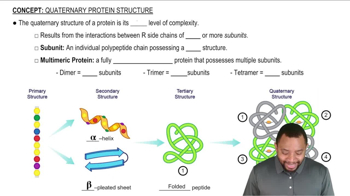Determine whether each of the following statements describes the primary, secondary, tertiary, or quaternary structure of a protein.
d. Hydrogen bonding between amino acids in the same polypeptide gives a coiled shape to the protein.
 Verified step by step guidance
Verified step by step guidance Verified video answer for a similar problem:
Verified video answer for a similar problem:



 2:56m
2:56mMaster Summary of Protein Structure Concept 1 with a bite sized video explanation from Jules
Start learning